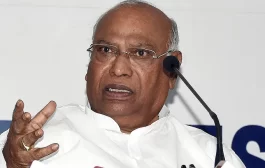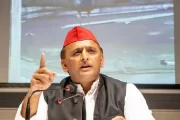
When India recently responded decisively to Pakistan-sponsored terrorism, the name of its military operation did more than just describe an act of war—it shook the enemy not just on the battlefield but also on the cultural and ideological front. That name was Operation Sindoor.
This wasn’t just a regular military code. It was a living cultural statement, emerging from the soul of India. It wasn’t revenge, but a response. It wasn’t just a military action; it was a symbolic and ideological message as well.
The pain and anger behind this name came from the terrorist attack in Pahalgam, where newly married couples were targeted—young men beginning a new chapter in life, whose wives still had fresh mehendi on their hands and sindoor (vermilion) on their foreheads as a symbol of hope and love. This brutality didn’t just hurt families—it wounded the spirit of the nation.
This time, India didn’t just use guns—it chose words that cut deep into the enemy’s mind and soul. The name Operation Sindoor became a powerful cultural message: India will now respond not only with bullets but with pride. In Indian culture, sindoor is not just a cosmetic. It symbolizes trust, purity, dedication, and the assurance of life. It reflects the sacred bond of marriage and a woman’s strength and faith. When a newlywed’s sindoor is wiped away by her husband’s blood, it’s not just her personal grief—it’s a national sorrow. Operation Sindoor was India’s decision to cleanse that wound.
Naming the operation this way gave it a deeper meaning—it became more than war, a cultural and ideological statement. India declared that future wars wouldn’t just be fought at the border but also in the minds and hearts. It is a fight for ideas, for symbols, and for pride.
This time, the announcement was also unique. When the military operation was made public, two female officers stood on stage to address the nation. This wasn’t a coincidence. It was a reflection of a new India, where women are not just seen as symbols of endurance but of power and courage. This is an India where daughters not only defend the borders but also plan the attacks.
Operation Sindoor was more than a military move. It was the voice of a changing India—confident, culturally strong, and ready to rise. It was a message against those who still think India is silent, tolerant, or submissive. India is no longer silent—it speaks out. Tolerance is not its weakness, but a mark of wisdom. But when it comes to the dignity of its women and its culture, India is ready to roar.
Unfortunately, some so-called intellectuals and political critics mocked the name. They ridiculed the use of a cultural symbol like sindoor, forgetting that this very sindoor represents the hopes and prayers of millions of Indian women—who fast for their husbands, sons, and brothers, whose foreheads shine with this red mark like a symbol of hope.
Prime Minister Narendra Modi’s address to the nation wasn’t just a warning—it was a cultural declaration:
“Anyone who casts an evil eye on India’s mothers and sisters will face consequences more severe than ever before.”
These are not just words—they now define India’s foreign and security policy.
Operation Sindoor wasn’t just a mission plan—it became a source of emotional strength for soldiers. It reminded them they weren’t just guarding borders, but protecting the sacred sindoor on every Indian woman’s forehead. It became a source of psychological strength—not from bullets, but from emotion and belief. This operation reflects the new India—technologically advanced, ideologically awake. It understands that modern wars are not only fought with tanks and missiles, but with ideas and symbols. When the name of a mission itself becomes a cultural weapon, it is more powerful than any gun.
Operation Sindoor is the foundation of a future strategy—where India will include its cultural values in its language of war. This is a new model of cultural nationalism—where traditions are not just memories of the past but strength in the present. This name is a warning for those who attack India’s soul. India is no longer emotional—it is decisive. It will now respond, not just endure. Anyone who attacks its culture, its women, or its spirit will face an answer—not just at the borders, but from the depths of India’s soul. That is the true meaning of Operation Sindoor.
Even on a psychological level, this name defeated the enemy. When they heard the name, they couldn’t understand the level at which India was fighting. This name lodged itself in the enemy’s mind like a missile. This was not just an operation—it was the return of an India that has always drawn strength from its values. India has now made it clear: war is no longer just about weapons—it is also about ideas, symbols, and inner strength.
Those who ask, “Why name the operation Sindoor?” clearly don’t understand the soul of India. They don’t realize that when the sindoor on a woman’s forehead is wiped away, it’s not just a personal loss—it’s a wound to the nation’s identity. And when terrorists killed newlywed husbands in Pahalgam, they trampled that sindoor. That’s why Operation Sindoor wasn’t just a name—it was a vow. A vow that India will no longer remain silent. It will protect every sindoor.
This operation, just through its name, signaled a revolution in thinking. It was a moment when weapons and wisdom came together. When India declared: Bravery is not just in the sword, but also in thought. Operation Sindoor is a warning to all those who underestimate Indian womanhood, who call our culture backward, who believe India is still overly emotional. Yes, India is emotional—but now its emotions have become weapons. India no longer weeps—it thunders.
India has changed. It no longer fears bullets or criticism. This India responds to mockery with determination. And this India will fight to protect every mother, sister, and daughter’s sindoor—and wear that fight as a badge of honor for the world to see.
Operation Sindoor is not the end—it is a new beginning. Now, every cultural symbol will be part of India’s strategy. Every insult will be answered—not only with tradition but with action. India will now fight not just with geography, but with ideology. Every wound—emotional or territorial—will be answered. And the answer will come not just through guns, but through sindoor.
This is the story of an India that no longer sees faith as weakness. That sees symbols not just as tradition but as inspiration. An India that salutes every woman who wears sindoor not just as decoration, but as a living expression of values, devotion, and resolve. Those who hurt this spirit will now be answered—clearly, strongly, and culturally.
Operation Sindoor is the roar of this new India.
Jai Hind!

Asif Zaman Rizvi
The views expressed in the above article are the author’s own.





































